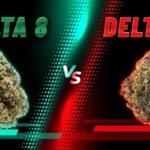Cannabis — also known as weed or marijuana — comes in many different forms. You’re probably familiar with smoking or vaping. After all, it’s the most popular way to consume cannabis. But more people are trying edible cannabis products as an alternative to smoking or vaping.
All cannabis products can have side effects, though inhaling cannabis can be particularly damaging to your lungs. So, how do edibles compare to other cannabis products? And how long do the effects from a cannabis edible last?
What are cannabis edibles?
Edibles are foods and drinks that have cannabis cooked or infused into them. There are lots of different types of edibles:
- Breath mints
- Candies
- Chocolate
- Savory snacks
- Ice cream
But not all cannabis-infused edibles contain the same active ingredient (or cannabinoid). As with all cannabis products, edibles usually fall into one of three main categories:
- Tetrahydrocannabinol (THC)-dominant edibles
- Cannabidiol (CBD)-dominant edibles
- Edibles containing a balanced amount of both THC and CBD
THC and CBD are the main cannabinoids (active ingredients of cannabis) most people know about. But edibles may also contain other minor cannabinoids, such as:
- Cannabigerol (CBG)
- Cannabinol (CBN)
- Delta 9 tetrahydrocannabivarin (THCV)
Based on what type of cannabinoid your edible contains, you’ll feel different effects when consuming it. Higher THC edibles typically have a more intoxicating or psychoactive effect. Edibles with greater levels of CBD cause less of a “high,” but they may make you feel relaxed and less anxious.
EXPERT PICKS: WHAT TO READ NEXT
- THC dosages: Cannabis products contain different amounts of THC. Here are tips on safe cannabis use.
- CBD vs. CBN: There are different types of cannabinoids in the cannabis plant. Learn the distinct effects of CBD and CBN.
- Microdosing: The practice of taking tiny amounts of psychedelics has grown in popularity. Are there any benefits?
How long does it take for an edible to kick in?
In most cases, you won’t feel the effects of a cannabis edible right away. That’s because most edibles need to go through your digestive system and liver before moving to your bloodstream and eventually your brain. Edibles often start to take effect after about 30 to 120 minutes. And it can take up to 4 hours before you feel the full effect.
How long do edibles last?
Similar to how most edibles take time to kick in, the effects can last a pretty long time. The effects of a cannabis edible can last an average of 6 to 12 hours — and sometimes even longer.
Keep in mind that cannabis affects people differently, so this timeframe may not match your experience. Lots of things will influence how long you may feel the effects of an edible, from your genetics to your physical activity and the other things you eat. The type of edible and its ingredients can make a difference too.
Good to know: The cannabis industry is evolving quickly, and there are lots of different products available. Nanoformulation is just one example. This makes the cannabis particles in an edible really, really small. Smaller particles are easier for the body to absorb, so these products work faster than traditional edibles. Most nanoformulated edibles work within 15 to 30 minutes and last just a few hours.
What’s the difference between inhaled vs. edible cannabis?
The way you use cannabis affects how your body processes it. In fact, the THC you eat or drink is processed into a form of THC, known as 11-hydroxy THC, that has a stronger effect on the brain. And the timing of the effects are different. When you inhale cannabis, it’s absorbed through your lung tissue directly into your bloodstream. So the first effects occur within seconds. And those effects can last around 2 to 3 hours.
When you eat or drink cannabis products, the cannabis gets digested, absorbed, and processed in your stomach, intestines, and liver. The way the body processes cannabis changes how you’ll experience it. Again, cannabis edibles usually have a delayed effect — it can take anywhere from 30 to 120 minutes. And the effects can last 6 to 12 hours — a lot longer than when you smoke cannabis.
These longer timeframes mean it’s especially important to start with low doses and go slowly with edibles.
How much THC is usually in an edible?
The amount of THC in an edible cannabis product can vary a lot. Researchers have proposed using 5 mg as the THC dosing standard. This consistency allows researchers to better compare studies. But this standard measurement doesn’t mean that it’s safe or recommended to take that amount of THC. Nor does it mean that all edibles come in units of 5 mg.
Knowing what to look for on an edibles label can help you make an informed decision. There are two big things to know when reading labels for cannabis edibles:
- THC dose: This is usually listed in milligrams (mg). The label may list the dose for the whole package or just one edible. For example, a container of gummies may say “100 mg THC.” That often means there’s 100 mg of THC in the whole container. So, if there are 20 gummy bears, each gummy has 5 mg of THC in it.
- Balance of THC and CBD: CBD may reduce some of THC’s intoxicating effects. So a formulation with more CBD than THC may be a good place to start if you’re new to cannabis edibles. The balance of CBD and THC is often listed as a ratio, like 1:20, 20:1, or 1:1. But the order of these ratios (which number represents THC and which represents CBD) can be different depending on where the product is sold. So make sure to read the label carefully, and ask questions if you aren’t sure.
What’s the right edible dose for you?
The “right” edible dose for someone depends on many different factors. The right dose will vary for each person since each body processes and experiences cannabis differently. Researchers are still learning a lot about why cannabis affects people differently.
A good rule of thumb is to start slowly and with low doses. Before taking more, wait at least 2 hours after your first dose. And if you’re new to edibles, avoid taking another dose until you see when and how you respond to the first one.
With that in mind, here are few things that can affect how you respond to cannabis edibles:
- Genetics: Edible cannabis products are processed by enzymes (proteins) in the liver. Some people have more of these enzymes — so they’ll process cannabis faster than other people.
- Overall health: Cannabis works by interacting with your body’s endocannabinoid system (ECS). How you respond to cannabis depends on the health of your ECS. Your ECS changes all the time based on things like stress, diet, and exercise. So the same edible may give very different results if you consume it at different times and under different circumstances.
- Meal timing: It takes longer to feel the effects of an edible if your stomach is full. That’s because your body has to process all the food in your stomach, including the edible. But the type of food matters too. Cannabis dissolves in fat, so fatty foods help your body absorb more cannabis.
Manufacturers of cannabis and some organizations have their own recommendations on how much cannabis to take. These recommendations take into account why someone is using cannabis in the first place.
For chronic pain, for example, a group of experts recommend starting with high-concentration CBD and then adding THC as needed to help with symptoms. They recommend starting at 2.5 mg of THC and slowly raising the dose as needed up to a maximum of 40 mg of THC per day.
Are edibles bad for you?
Just like prescription medication or other herbal supplements, cannabis can have side effects and drug interactions. Cannabis also has a potential for misuse and addiction. Estimates show that almost 1 in 10 people who consume cannabis may develop cannabis use disorder.
Cannabis edibles can also make it easier to consume more than you mean to. A large dose of THC can easily fit inside a single gummy bear. And many people consume more of an edible thinking their first dose hasn’t kicked in, when in reality they just didn’t wait long enough.
While you probably won’t die from eating too much THC, the side effects may be very unpleasant. And they may also cause you to make poor decisions — like driving while intoxicated — that could put your life at risk.
Buying cannabis outside of a state-regulated dispensary can increase the risk of contaminants or other illicit substances. So, to help ensure your safety, stick to state-regulated dispensaries.
Are edibles bad for your heart?
Using cannabis, and specifically THC, can have dangerous effects on the heart. Researchers have long known that THC can cause the heart to beat faster. This is one of the most common physical side effects of cannabis. For most people, this isn’t a serious issue, and heart rate returns to normal after 10 to 15 minutes.
A 2021 clinical study showed that edible cannabis caused this side effect less often than inhaled cannabis. CBD may also reduce the chance you’ll have a rapid heart rate from THC.
Newer research has found a higher risk of heart attack and stroke among people who use cannabis. This risk went up along with increased use.
If you have a history of heart problems, it’s best to talk with your healthcare team before taking any cannabis products containing THC. Get emergency medical care if your heart rate stays fast for longer than 15 minutes or you also have chest pain after consuming cannabis.
The bottom line
Cannabis edibles come in many different forms, from candies and mints to beverages. They don’t put your lungs at risk the way smoking cannabis can, but they aren’t free of risk. Most edibles take longer to kick in, and their effects last longer. So it can be easy to consume too much.
It’s a good idea to start with a low dose of THC (2.5 mg) or a high-CBD formulation when you’re taking edibles for the first time. And be sure to buy regulated cannabis products from a licensed dispensary to ensure the product contains what it’s supposed to.
If you or someone you know struggles with substance use, help is available. Call SAMHSA’s National Helpline at 1-800-662-HELP (4357) to learn about resources in your area.
References
Antoniou, T., et al. (2020). Drug interactions with cannabinoids. Canadian Medical Association Journal.
Barrus, D. G., et al. (2016). Tasty THC: Promises and challenges of cannabis edibles. Methods Report.


